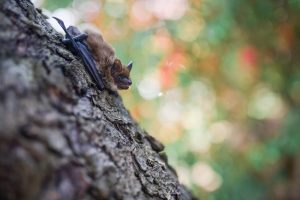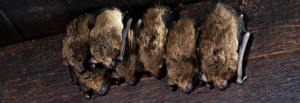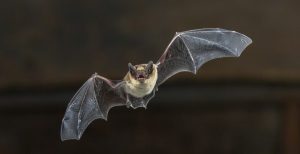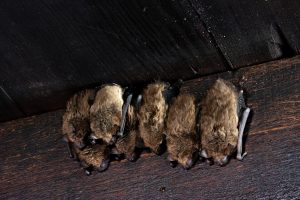Bats are the second largest order of mammals after rodents, clocking in at a staggering 1,400 distinct species, 47 of which live in the United States (here are some of the coolest).
There is a tremendous amount of diversity among US bats, especially in size. The smallest is the western pipistrelle, which grows to 2.5—3.5 inches, with an 8-inch wingspan—this meager bat weighs less than a penny. The largest U.S. bat is the greater mastiff bat, which can grow to seven inches or more, with a wingspan of over 21 inches.
Bats also hold the distinction of being the only mammal in the world capable of flight. In order to make flight possible, bats digest food at a speedy pace, sometimes excreting within 30 to 60 minutes after eating. This helps them keep their weight down so their arial maneuvers are as easy as possible.
Bat Lifespan
In temperate climates, bats usually give birth between May and July. Gestation can take anywhere from six weeks to six months.
Bats give birth to live young, one pup at a time, which they nurse with milk until the pup is able to eat on its own. When bats are born, the pups are blind and helpless. A baby bat clings to its mother fiercely at first, and the mother only leaves for short periods in the evening to hunt.
Bats often gather in colonies called “maternity roosts” during their birthing season. The birthing season takes place between late May and about mid-August.
Maternity roosts are basically groups of female bats who come together to take turns raising their young.
As pups grow and develop, mothers slowly increase their hunting time to wean their offspring. Once the baby bats are about five weeks old, they begin to fly and hunt but may still nurse until they can feed on their own.
How Long Do Bats Live?
Most bats live less than 20 years in the wild, but six species can live more than 30 years!
When a baby bat is born, it is blind and virtually helpless. They are totally reliant on their mother until they are about five weeks old, at which point they can begin flying and hunting. Some species reach full size as quickly as two months.
Since baby bats are completely reliant on their mother and have little to no capacity for self-preservation, many of them die from accidents while flying or falls from high nesting places. Many bats do not live to maturity.
Once bats mature, though, their mortality rate drops significantly. Bats have few natural predators and can live a very long time; although most bat species live less than 20 years in the wild, scientists have identified six species that can live in excess of 30 years. In 2006, one tiny bat from Siberia reached the ripe old age of 41—that’s the average life expectancy of an American, circa 1885!
Some bats return to the safe roost year after year. So if you have bats in your attic, it might turn into a 30 year problem
Where Do Bats Live?
Bats are found throughout the United States, Puerto Rico, and the US Virgin Islands. The Hawaiian Hoary bat is the only native, terrestrial mammal on the Hawaiian Islands.
Bats can be found in almost every kind of habitat. They live in deserts, woodlands, caves, suburban communities, and cities. Bats’ natural habitat usually takes the form of caves, or holes and gaps in rocks, as they provide ample protection from predators.
Bats are also known to live in trees, but they do so reluctantly, as they are more exposed than caves and structures. Bats hang upside down to simply drop into the flight instead of getting a running start and taking off. They need a location with rough surfaces that they can hang from, as well as a certain amount of height and width to allow them to both enter into flight and land.
Bats will also readily inhabit human structures such as attics, mines, bridges, and chimneys. Perhaps the most famous bat roost in the US is the Congress Avenue Bridge in Austin, Texas. According to Bat Conservation International, between 750,000 and 1.5 million bats reside under the bridge each summer, and the evening spectacle of them flying out from underneath the bridge in search of food attracts as many as 100,000 tourists annually.
Bats in Human Spaces
Many of the qualities bats value in a habitat—such as security from predators, space, and proximity to food and water—can be found in human structures, and as many homeowners already know, bats have no reservations about setting up shop in your house.
There are several signs that can indicate the presence of bats. One is a persistent, musty, ammonia-like smell that bat feces is known to emit. Another sign is the droppings themselves, which are small cylinders, usually crumbly in texture and tapered at the ends. Yet another sign of a bat infestation is oily stains on the walls of the roost site. Bats secrete oil through their chest, and when they rub against the walls of the roost site, the oil is imparted to the wall. These stains start out as mere discolorations, but over time become dark oily stains.
A bat infestation can be a serious problem, as bats commonly carry rabies, and their droppings may facilitate the growth of histoplasmosis. For this reason, direct contact with bats should always be avoided. If you hear what you believe to be bat noises in your home, or have noticed bat excrement, contact Trutech Wildlife. Our team has the knowledge and resources to assess, and resolve, the situation quickly and safely.
Call Trutech In to Get Bats Out
Bat Removal Near You

Bats in Jacksonville, FL
There are 13 species of bats in Florida; several of these, including little brown and big brown bats, may be found in residential homes and

Bats in Tampa Bay, FL
Florida is home to thirteen bats, and all of them eat insects. Residents in Tampa Bay can experience incredible benefits from bats on their property.

Bats in Orlando, FL
Bats are found in nearly every geographic region in Florida. Their favorite environments include tropical forests, woodlands and open fields. Natural roosting spots include caves,

Bats in Kansas City
Kansas is home to fifteen species of bats, and all of them are insectivores. Bats in Attic in Kansas City Bats in Kansas naturally roost

Bat Removal in Northeast Ohio
There are eleven species of bats commonly found in Ohio. The solitary species are the hoary bat, the silver-haired bat, and the Eastern red bat.

Bat Removal in Raleigh
The most humane way to get rid of bats is to let them evict themselves. A bat valve allows bats to fly out of your


